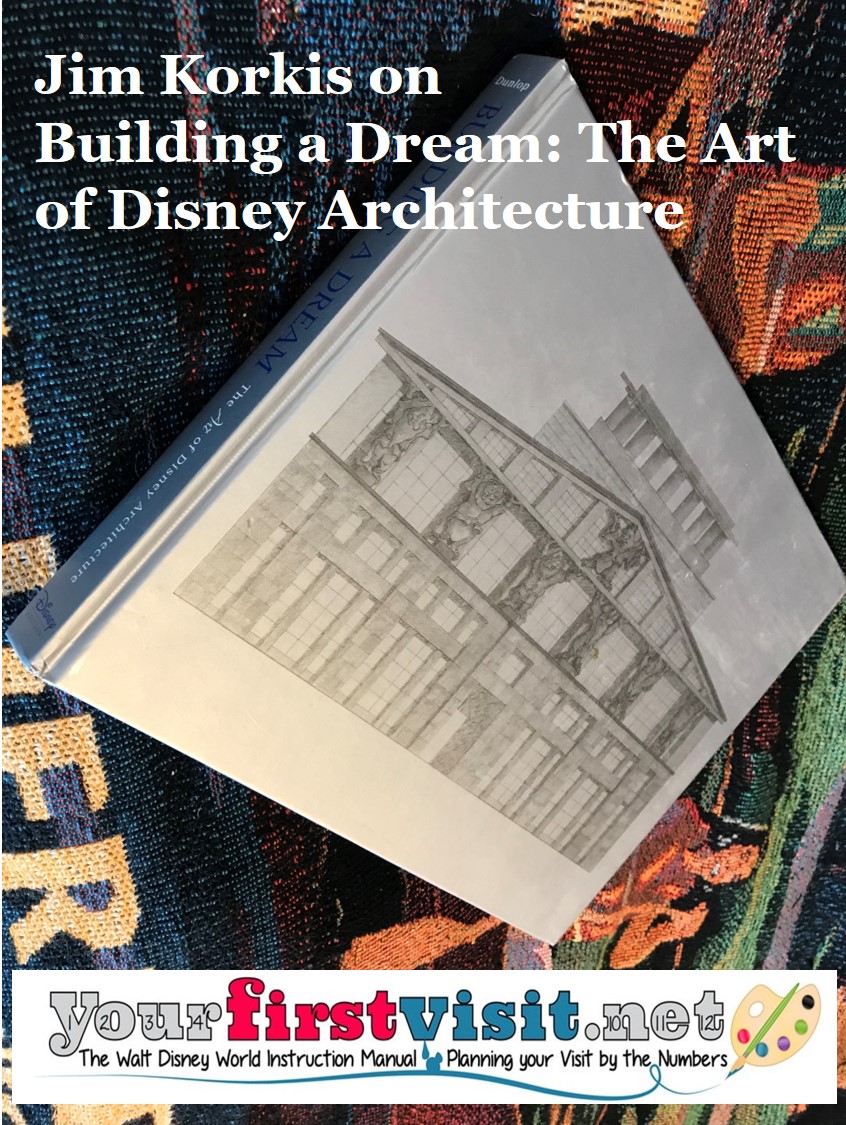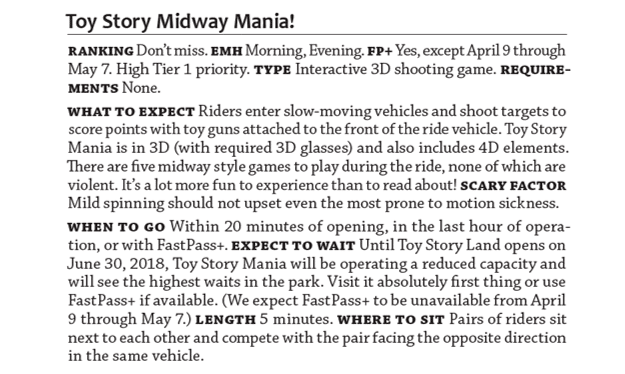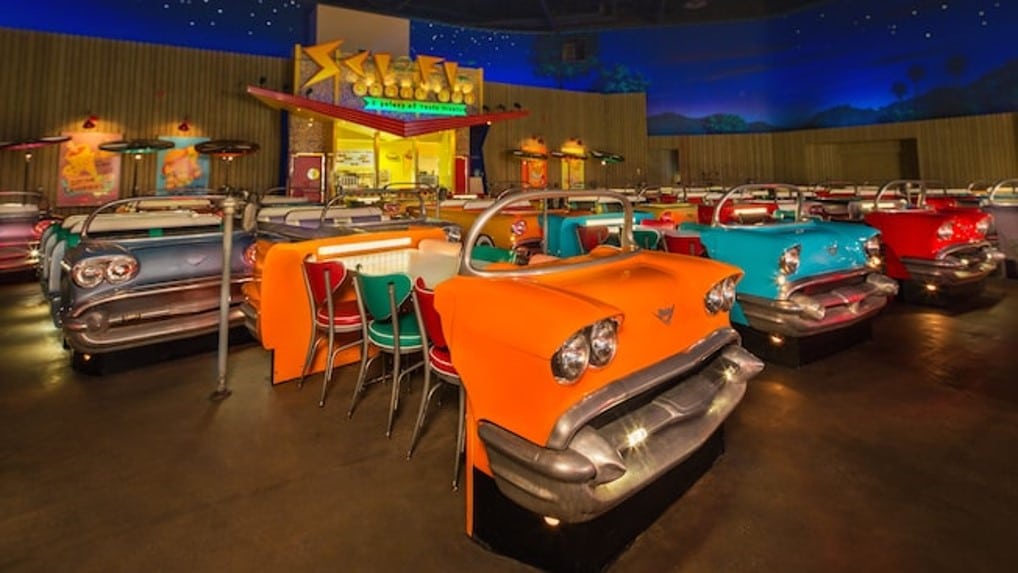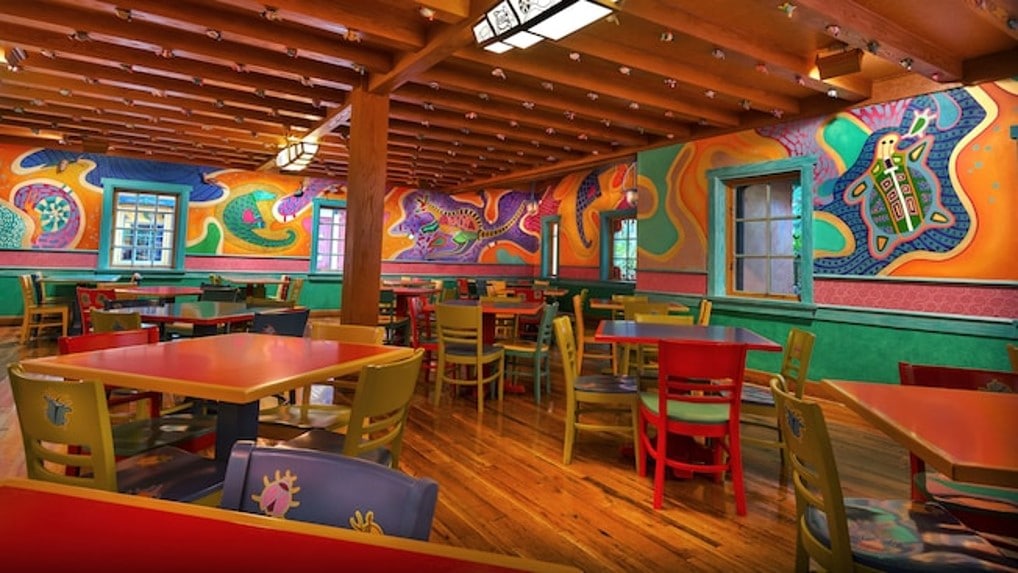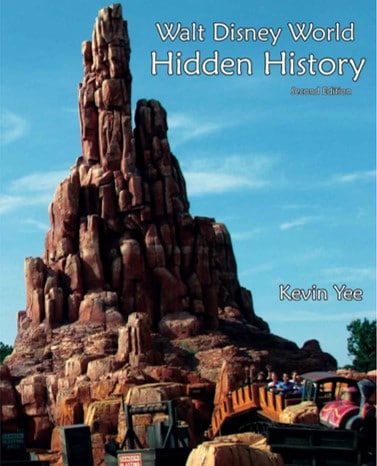Category — A Friday Visit with Jim Korkis
A Friday Visit with Jim Korkis: The Redhead at Pirates of the Caribbean
Welcome back to Fridays with Jim Korkis! Jim, the dean of Disney historians, writes about Walt Disney World history every Friday on yourfirstvisit.net.
THE REDHEAD AT PIRATES OF THE CARIBBEAN IN MAGIC KINGDOM
By Jim Korkis
For fifty years, since 1967 at Disneyland, guests drifted by a scene in Pirates of the Caribbean in Disney parks where intimidating pirates are holding female captives and putting them on an auction block with a huge banner above their heads proclaiming, “Auction. Take a Wench for a Bride.”
Starting in 2018, no longer are the women auctioned off. The banner is changed to read “Auction. Surrender Ye Loot.” One of the most distinctive women in the scene, a self-assured redhead now known as Redd, has become a musket-carrying pirate with a bottle of rum on her hip, helping in overseeing the surrender of the town’s “loot” and auctioning it off to her fellow pirates.
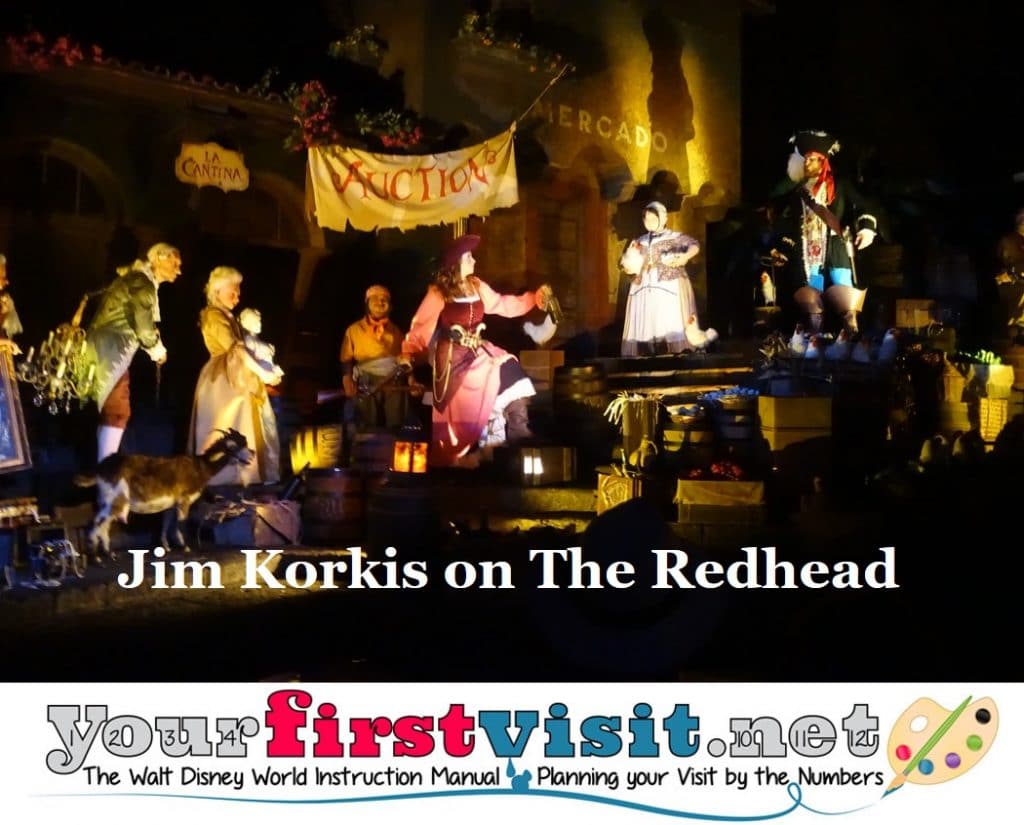
Of course, the attraction was never meant to be historically correct. It is doubtful that pirates ever auctioned off women. It is more likely they simply took whatever they wanted by force whether it was loot or physical female companionship.
However, especially recently, the issue of sexual slavery has become a more prominent issue even though it has existed for centuries. Some claim that the attraction shows tacit approval of such an action, even if it is cloaked in the aura of fantasy and that the pirates get their tragic comeuppance.
Something that rarely occurs to guests is that the Redhead is the only female with the color red in the scene. Her clothes are more expensive, emphasizing a pronounced bust. Her hat is very stylish. She wears more make-up. She even originally had a beauty spot on her right cheek. She doesn’t reflect any of the awkwardness or fear of her fellow companions.
Even the auctioneer has to reprimand her, “Strike yer colors, ya brazen wench! No need to expose yer superstructure!”
Based on Davis’ original research and early sketches, she is obviously a popular and well-off lady of the night, the town prostitute, who is well aware of what her fate might be and is already negotiating to get top dollar, realizing that she is much smarter than whoever purchases her.
She is not a victim. In fact, she realizes that the drunker these unsavory scoundrels get, the more in control she can be of the situation, even to the point of being able to escape.
Marc Davis told me that he believed that after she was sold, she became a pirate herself and took over the ship. He suggested that the eye-patched woman wearing a pirate hat in the painting over the bar in the early part of the attraction was what happened to her in later years. However, her new costume in the new scene is much more demure than real life female pirates Anne Bonney and Mary Read, who Davis sketched for the original walk-through attraction.
Walt Disney had initially expressed some concerns to Imagineer Claude Coats about whether the scene was appropriate, but it was pointed out that the scene was purposely staged with humor so that the men seemed like raucous boys rather than real threats.
By putting up the banner to buy a bride, it transformed them from licentious reprobates to lonely men who couldn’t get a wife on their own. Whether any of this alleviates anything in this day and age is debatable.
* * * * *
Thanks, Jim! And come back next Friday for more from Jim Korkis!
In the meantime, check out his books, including his latest, More Secret Stories of Disneyland, and his Secret Stories of Walt Disney World: Things You Never You Never Knew, which reprints much material first written for this site, all published by Theme Park Press.
Follow yourfirstvisit.net on Facebook or Twitter or Pinterest!!
June 29, 2018 No Comments
A Friday Visit with Jim Korkis: Building a Dream
Welcome back to Fridays with Jim Korkis! Jim, the dean of Disney historians, writes about Walt Disney World history every Friday on yourfirstvisit.net.
YOUR PERSONAL DISNEY LIBRARY (7)
By Jim Korkis
- Building a Dream: The Art of Disney Architecture by Beth Dunlop (2011).
Some books that should be in your personal library about Walt Disney World may, in fact, not be totally devoted to WDW. There may only be a chapter or several chapters that focus on the Florida vacation destination, but even so, that material may not exist elsewhere, and it can enhance your appreciation.
In addition, some books resemble the academic texts or concentrate on a narrow topic. Today’s book is an example of a significant book that is filled with accurate, out-of-the-ordinary information about the history, conception and building of Disney architecture but may not seem very entertaining to a general reader.
In 1996, Beth Dunlop, the long-time architecture critic of The Miami Herald newspaper, as well as contributor to articles for architecture, design and travel magazines (in particular, articles on Florida architecture), wrote the first edition of Building a Dream: The Art of Disney Architecture. It was published in portrait format by Harry N. Abrams Publishers.
Fifteen years later in 2011 she revised and updated it in landscape format for Disney Editions. The 2011 edition of Building a Dream: The Art of Disney Architecture includes a foreword by Tom Staggs and Bruce Vaughn, and an afterword by Wing T. Chao.
[Oddly, Amazon may show the wrong cover–Dave]
So while the two books share many similarities, there are enough significant differences that a Disney fan may seriously consider having both editions. However, if your collection only has room for one copy, I would recommend the newest version.
Since this is a book about architecture, the intent is to focus on the buildings, and most of the photos lack any human presence, which some may argue is troubling because it is only with the interaction with people that architecture truly comes alive and serves its function much like a stage set for a play. I personally don’t find that a flaw because the lack of people allows me to better study the structure and details.
In the first edition, at least half the photos were in black-and-white. The newer edition is filled with full color photos, sometimes several to a page. So, if you have only a casual interest in architecture, it does easily serve as a stunning picture book to flip through and marvel at the theatricality of it all.
Since this is a Disney approved text, there is no overt criticism of any Disney architecture and sometimes that is avoided by simply not mentioning any missteps in the first place.
Primarily, there are three main chapters devoted to Walt Disney World. One concentrates on the parks, another on the resorts, and finally one focuses on the city of Celebration. Celebration today is no longer considered “Disney,” but the chapter gives insight into the architects who worked on that project. Moreover, there are also scattered sections throughout the book devoted to WDW’s Casting Center, Team Disney Building and Reedy Creek firehouses.
The rest of the book covers Disneyland, Disneyland Paris, New Amsterdam Theater, Disney Cruise Line and other topics. The first book was much more of an homage to the accomplishments of former CEO Michael Eisner who was a champion of architecture. He is still acknowledged as a key instigator in the newer edition but is not as prominently showcased.
Personally, I have always been fascinated by Disney architecture and why certain choices were made. As Wing Chao, Imagineering executive vice president for Disney design and architecture writes, “each building has its own story, from design inception through the development process to completion. Disney architecture in unique.”
Dunlop’s book has a good index (rare in Disney books), several pages of bibliography for those who want to explore the subject further, and is filled with direct quotes from those who actually designed and built the buildings. I have both editions on my personal library bookshelf.
* * * * *
Thanks, Jim! And come back next Friday for more from Jim Korkis!
In the meantime, check out his books, including his latest, Call Me Walt, and his Secret Stories of Walt Disney World: Things You Never You Never Knew, which reprints much material first written for this site, all published by Theme Park Press.
Follow yourfirstvisit.net on Facebook or Twitter or Pinterest!!
June 22, 2018 No Comments
A Friday Visit with Jim Korkis: Toy Story Midway Mania at Disney’s Hollywood Studios
Welcome back to Fridays with Jim Korkis! Jim, the dean of Disney historians, writes about Walt Disney World history every Friday on yourfirstvisit.net.
TOY STORY MIDWAY MANIA
By Jim Korkis
The highly popular Toy Story Midway Mania! attraction opened at Disney’s Hollywood Studios on May 31, 2008 in the area labeled Pixar Place. It was John Lasseter’s suggestion that the archway entrance look like the entrance to the real Pixar Studios in Northern California, even using the same type of brick.
At the Studios, as park guests enter the attraction, they find themselves in Andy’s room from the 1995 Pixar animated feature film Toy Story which is strewn with board games, puzzles and other toys. The murals located in the load area are the biggest murals painted since Epcot was built.
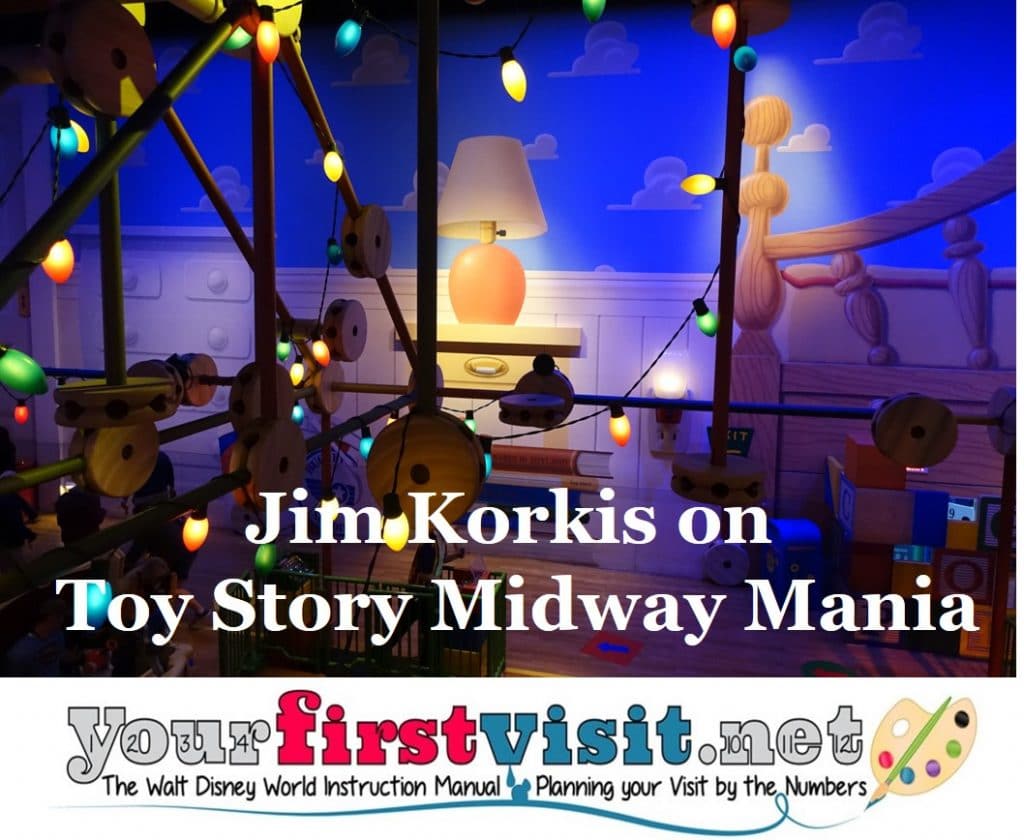
According to the back story, Andy has received the Midway Games set for his birthday. However, before he can completely set it up and play with it, he is called away and Andy’s toys decide to set up and play with the set themselves.
The Mr. Potato Head Broadway Barker figure (the most complex audio-animatronics figure ever built by Disney) is actually not part of the set itself but an additional figure that was “sold separately” as can be seen by his boxy stand and backdrop. Imagineers spent more than thirty hours with comedian Don Rickles who was the voice of the character in the original films to record his dialog.
The idea for the eighty million dollar attraction began in May 2005, when Imagineers were working on the concepts for Cars Land at Disney’s California Adventure and thinking about how they could bring some interactive components to the area. They later discarded those ideas as infeasible for the new land but were still intrigued by the initial concept.
After some in-depth research at the local Los Angeles County Fair with classic midway games, the idea progressed. The pull-string shooter was inspired by the Pirate Adventure game at DisneyQuest. In order to create a show that responds not only to every pull of a guest’s spring-action shooter, but also every move their midway tram makes, there are more than 150 computers communicating over multiple networks throughout the attraction.
Imagineers Lori Coltrin, her brother Robert Coltrin, Roger Gould and Kevin Rafferty were the primary team on the attraction.
The look of the attraction was inspired by a game that one of the Imagineers had as a kid called Snoopy and the Red Baron which is why there appears to be cardboard backdrops, stickers, and pieces molded out of single color of plastic.
In their test group, the Imagineers saw noticed young children were reluctant to break the plates so they added the line where Sarge yells: “I am not your mother -break those plates!”
Typically over one million of the virtual China plates are broken every single day. The green army men work hard to clean up the plate shards as plates are shattered all around them, although most riders never pay attention to that action.
Toy Story Midway Mania is the first blacklight show viewed with 3D glasses, which made mixing the paint colors more of a challenge. The Imagineers involved in the art direction had to always carry 3D glasses around with them when they were working inside the attraction.
The attraction opened before Toy Story 3 was released, so in May 2010, Disney changed the mini game, “Bo Peep’s Baaa-loon Pop”, and replaced it with “Rex and Trixie’s Dino Darts”. Trixie was a new character introduced in the new film, as was Buttercup who was added to the Hamm and Eggs game.
The attraction was so popular that a third track was added in May 2016.
* * * * *
Thanks, Jim! Toy Story Midway Mania will become part of Toy Story Land on June 30, 2018.
Here’s the review of attraction from The easy Guide to Your Walt Disney World Visit 2018:
And come back next Friday for more from Jim Korkis!
In the meantime, check out his books, including his latest, Call Me Walt, and his Secret Stories of Walt Disney World: Things You Never You Never Knew, which reprints much material first written for this site, all published by Theme Park Press.
Follow yourfirstvisit.net on Facebook or Twitter or Pinterest!!
June 15, 2018 No Comments
A Friday Visit with Jim Korkis: The Sci-Fi Dine-In Theater at Disney’s Hollywood Studios
Welcome back to Fridays with Jim Korkis! Jim, the dean of Disney historians, writes about Walt Disney World history every Friday on yourfirstvisit.net.
SCI-FI DINE-IN THEATER RESTAURANT
By Jim Korkis
The Sci-Fi Dine-In Theater restaurant at Disney’s Hollywood Studios is a huge soundstage with high, dark ceilings made to resemble the starry nighttime sky, and row upon row upon row of 1950ish convertible automobiles that serve as the dining area for the guests.
It is meant to resemble the classic drive-in movie theaters of the era. For those who prefer not to be in a car, just like in a real drive-in, there are a few picnic table and tables with umbrellas available along the back as well.
All of the seating is aimed toward a massive movie screen on one side of the room. The forty five minute film loop compilation that shows there of coming attraction clips of 1950s science fiction films, cartoons, vintage news clips, and intermission/refreshment announcements was put together by Stephanie Keith of Theme Park Productions.
She spent hundreds of hours visiting film libraries and collectors as well as the National Film Archives in Washington, D.C. to review old news footage. “Some of the prints were pulled out from dusty boxes in the back of someone’s garage,” said Keith. Some of the film was in very poor condition that required extensive restoration.
“It was a challenge to make a piece of film look good but not too good,” post production supervisor Louise Gladden said. “We needed to keep some of the scratches, which add to the charm of the film.”
The film trailers include:
- Devil Girl from Mars (1954)
- It Conquered the World (1956)
- Attack of the 50 Foot Woman (1958)
- The Amazing Colossal Man (1957)
- The Horror of Party Beach (1964)
- The Giant Gila Monster (1959)
- Frankenstein Meets the Space Monster (1965)
- Plan 9 From Outer Space (1959)
- Invasion of the Saucer Men (1957)
- Robot Monster (1953)
- Cat Women of the Moon (1953)
- Missile to the Moon (1958)
In addition there are two edited MGM animated shorts: Mouse Into Space (1962 Tom & Jerry) and The Cat That Hated People (1948 Tex Avery)
The News of the Future newsreels include segments of the kitchen of the future (from the Monsanto House of the Future), a radiation hazard suit, a flying disc, a mini-car model that drives itself on an electronic wire track embedded on the ground (in the driver’s seat was a ventriloquist dummy of Jerry Mahoney smoking a cigarette), a picture phone with a ten inch video screen, real chimps as “space cadets” riding on an amusement park rocket ride, a “frying saucer” and an automated nursery.
For Disney fans, there is a compilation to the song Great Balls of Fire, featuring a clip of Garco the robot, Disneyland’s Trip to the Moon astronauts on the moon, the flying jetpack man from Disneyland, a cartoon clip from Mars and Beyond, Tinker Bell introducing Tomorrowland from the weekly Disney television show, a costumed Mickey Mouse at the dedication of the new Disneyland Tomorrowland in 1967, as well as images of real rocket launches, Tom Corbett Space Cadet, and scenes from Forbidden Planet, Commando Cody, and The Thing.
Announcements include the warning that public demonstrations of affection will not be tolerated, the dangers of carbon monoxide poisoning if the car motor is running, the importance of disconnecting the speaker, an advertisement for the Satellite Space show for boys and girls, and more.
“Even though the Sci Fi Dine-In was designed as a restaurant first and an attraction second, it’s sometimes hard to set them apart,” said Imagineer Eric Jacobson. “It’s very strange to watch the guests, eyes riveted to screen as they eat and nobody is talking!”
* * * * *
Thanks, Jim! Here’s the review of the Sci-Fi Dine-In Theatre from The easy Guide to Your Walt Disney World Visit 2018:
And come back next Friday for more from Jim Korkis!
In the meantime, check out his books, including his latest, Call Me Walt, and his Secret Stories of Walt Disney World: Things You Never You Never Knew, which reprints much material first written for this site, all published by Theme Park Press.
Follow yourfirstvisit.net on Facebook or Twitter or Pinterest!!
June 8, 2018 2 Comments
A Friday Visit with Jim Korkis: Safari Village at Disney’s Animal Kingdom
Welcome back to Fridays with Jim Korkis! Jim, the dean of Disney historians, writes about Walt Disney World history every Friday on yourfirstvisit.net.
SAFARI VILLAGE AT DISNEY’S ANIMAL KINGDOM
By Jim Korkis
Safari Village was meant to be the thematic heart of Disney’s Animal Kingdom and serve as the central hub. Encircled by Discovery River, Safari Village [renamed Discovery Island in December 2010–Dave] was a lush, green island that serves as a magical departure point for each of the different realms of the park.
As the original promotional material stated, Safari Village
“… is a mix of tropical and equatorial styles featuring references to the Caribbean but also Polynesian influences. Strong, bright colors dominate the landscape. Animal forms decorate every possible surface of the one-story structures smothered in many-hued tropical foliage.
“A unique vocabulary of animal images, inspired by folk art from around the world, gives the Village a playful look that celebrates the beauty and power of animals. Safari Village’s shops make it the natural center of the park. It’s also the ideal place to encounter a unique brand of live entertainment celebrating the special connection between humans and animals.”
Safari Village has folk art inspired forms on every available surface including walls, ceilings, windowsills, gable ends and more.
The buildings are not just ornamented with animals, but also each facility has its own theme. Island Mercantile features animals that migrate and work – whales and wildebeests, bees and beavers. Creature Comforts features animals with stripes and spots. Beastly Bazaar has animals from fresh and salt water cavorting throughout it.
The clever theme of the Flame Tree Barbecue restaurant is predator and prey – prey are painted on the tables and predators on the chairs. Pizzafari’s dining rooms each have different themes. One room is dedicated to animals that hide in their environment. Another room is dedicated to animals that carry their houses on their backs like turtles, snails and hermit crabs. One room is based on animals that hang upside down.
For Safari Village, Imagineer Joe Rohde wanted to create a place no one had ever seen before. There are nine separate color schemes on Pizzafari alone.
“Jenna Goodman and I said, ‘You want it bright? We can do bright’.” said senior show designer Katie Olson. “When we did color design for Harambe we pored over books of photographs, trying to make sure we were rendering exact copies of a village in Kenya.
“Safari Village has a little bit of a tropical feelings but we just said, ‘I think lime green would look really good with this color’ and we tried it. At first, it was a little difficult breaking all the rules, but once we got into the rhythm of it, it became a really fun project.
“It didn’t have to be recognizable as anywhere in particular and that gives you a lot of freedom. But you have to still respect the form of the architecture. We used a lot of Caribbean color and references like Mexican wedding dresses and Oaxacan carved animals. If the color design successfully supports the overall story we are telling, the environment becomes that much more magical for our guests.”
Designers journeyed to Mexico to find basket weavers who could fashion wicker kangaroos to hold merchandise. In Oaxaca, Mexico, four hours down a dirt and boulder road, they found a family that carves and paints fantastically shaped animals. Imagineers ordered 300 bats, 120 bugs and 150 butterflies to hang in Pizzafari.
Principal production designer Ken Gomes actually relocated to Bali to oversee the production of more than one hundred hand-carved articles that were shipped to Florida for the Animal Kingdom each month. Gomes became part of village life, attending weddings and funerals and acquiring the native name of Wayan (“second-born”) Sin Ken Ken (“no problem”).
“The sense of community is refreshing,” said Gomes. “The talent and skill in Bali are incredible resources. They don’t realize how gifted they are.”
* * * * *
Thanks, Jim! Safari Village was renamed Discovery Island in December 2000, obviously because of the Discovery River but perhaps partly in homage to the old area of this name between the Contemporary Resort and the Wilderness Lodge.
And come back next Friday for more from Jim Korkis!
In the meantime, check out his books, including his latest, Call Me Walt, and his Secret Stories of Walt Disney World: Things You Never You Never Knew, which reprints much material first written for this site, all published by Theme Park Press.
Follow yourfirstvisit.net on Facebook or Twitter or Pinterest!!
June 1, 2018 No Comments
A Friday Visit with Jim Korkis: Walt Disney World Hidden History
Welcome back to Fridays with Jim Korkis! Jim, the dean of Disney historians, writes about Walt Disney World history every Friday on yourfirstvisit.net.
YOUR PERSONAL DISNEY LIBRARY (6)
By Jim Korkis
- Walt Disney World Hidden History Second Edition by Kevin Yee (2014)
When I bought the first volume of this book in 2010, I immediately wrote to Kevin to tell him how jealous I was over the title which I thought was a perfect way to describe some of the details that could be found at Walt Disney World. I wish I had thought of it for one of my own books.
This second edition contains all the gems from the first printing but with additional treasures as well. More importantly, it is better laid out and contains several color photos on each of the 135 or so pages to better illustrate the details being discussed.
It is important to realize that this is not a cohesive narrative but a scattering of nuggets that can be read in any order. He has a general chapter on Walt Disney World and then individual chapters devoted to each of the four theme parks.
Each detail is one paragraph long but some of those paragraphs are fairly lengthy. The end of the book includes several extras: A listing of the opening and closing dates of WDW attractions, a complete listing of the names on the Main Street U.S.A. windows (but no description of who these people are), and a four page chapter on the some of the hidden history details of Universal Studios Florida.
Kevin Yee is a former Disneyland cast member (for over ten years), author and blogger who writes about travel, tourism, and theme parks in Central Florida. He is a founding member of MiceAge (where his columns still sometime appear) and has written numerous articles and books about Disney parks since 1997.
He is also a faculty administrator at the University of South Florida and holds a Ph.D. in German Literature from UC Irvine and for years has kept his two worlds separate. His students are often unaware of his long interest in Disney and his Disney fans are sometimes clueless about his academic background.
I am particularly fond of his 2013 book The Original Grimms: Highlights of the 1810 Manuscript, where he translated the original manuscript of well known fairy tales before they got watered down and edited in the more commonly known versions. Of course, many of these tales later got translated into Disney animated feature films so there is a sort of “cross-over” that may entertain Disney fans as well. Yee teaches a popular Honors Seminar entitled Fairy Tales From Disney to Grimms and Beyond.
There are hundreds of fascinating entries in the WDW Hidden History book with three or four appearing on each page. Whether tribute or remnant, each item discussed starts with something visible in today’s parks. Yee’s idea is that this is something you could visit and see with your own eyes today, and then appreciate the historical thinking behind it being there. He captured several things I had never noticed which once again proves that no one can know everything about Disney.
Other books by Kevin you might explore include Magic Quizdom and 101 Things You Never Knew About Disneyland (both focused solely on Disneyland), Mouse Trap: Memoir of a Disneyland Cast Member, and the Unofficial WDW Earbook series.
* * * * *
Thanks, Jim! And come back next Friday for more from Jim Korkis!
In the meantime, check out his books, including his latest, Call Me Walt, and his Secret Stories of Walt Disney World: Things You Never You Never Knew, which reprints much material first written for this site, all published by Theme Park Press.
Follow yourfirstvisit.net on Facebook or Twitter or Pinterest!!
May 25, 2018 No Comments



